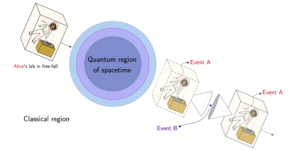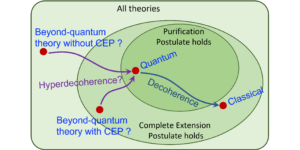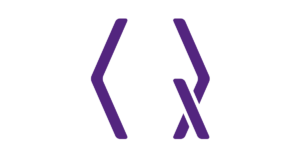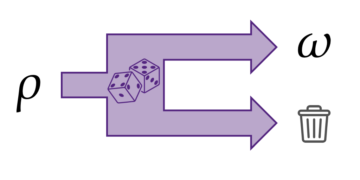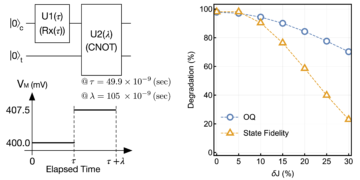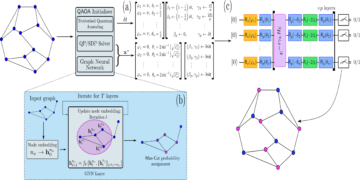1Hearne Institute for Theoretical Physics, Department of Physics and Astronomy, and Center for Computation and Technology, Louisiana State University, Baton Rouge, Louisiana 70803, USA
2School of Applied and Engineering Physics, Cornell University, Ithaca, New York 14850, USA
3School of Electrical and Computer Engineering, Cornell University, Ithaca, New York 14850, USA
Find this paper interesting or want to discuss? Scite or leave a comment on SciRate.
Abstract
Symmetry is a unifying concept in physics. In quantum information and beyond, it is known that quantum states possessing symmetry are not useful for certain information-processing tasks. For example, states that commute with a Hamiltonian realizing a time evolution are not useful for timekeeping during that evolution, and bipartite states that are highly extendible are not strongly entangled and thus not useful for basic tasks like teleportation. Motivated by this perspective, this paper details several quantum algorithms that test the symmetry of quantum states and channels. For the case of testing Bose symmetry of a state, we show that there is a simple and efficient quantum algorithm, while the tests for other kinds of symmetry rely on the aid of a quantum prover. We prove that the acceptance probability of each algorithm is equal to the maximum symmetric fidelity of the state being tested, thus giving a firm operational meaning to these latter resource quantifiers. Special cases of the algorithms test for incoherence or separability of quantum states. We evaluate the performance of these algorithms on choice examples by using the variational approach to quantum algorithms, replacing the quantum prover with a parameterized circuit. We demonstrate this approach for numerous examples using the IBM quantum noiseless and noisy simulators, and we observe that the algorithms perform well in the noiseless case and exhibit noise resilience in the noisy case. We also show that the maximum symmetric fidelities can be calculated by semi-definite programs, which is useful for benchmarking the performance of these algorithms for sufficiently small examples. Finally, we establish various generalizations of the resource theory of asymmetry, with the upshot being that the acceptance probabilities of the algorithms are resource monotones and thus well motivated from the resource-theoretic perspective.
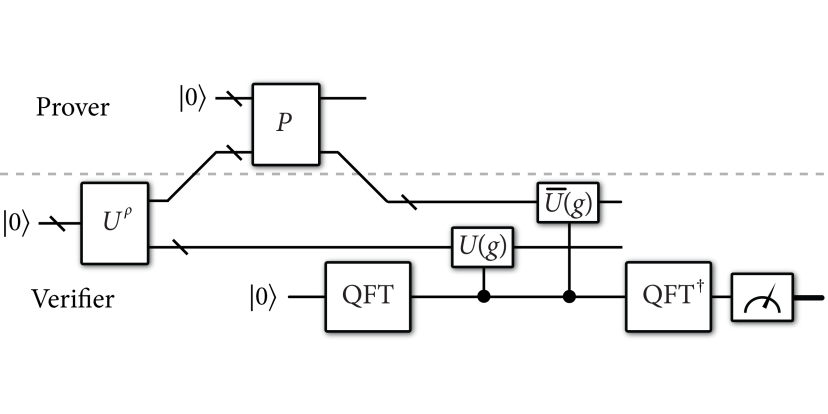
Featured image: Quantum interactive proof for testing G-symmetry of a quantum state.
► BibTeX data
► References
[1] Ugo Fano and A. Ravi P. Rau. “Symmetries in quantum physics”. Academic Press. (1996).
https://doi.org/10.1016/B978-0-12-248455-1.X5000-3
[2] David J. Gross. “The role of symmetry in fundamental physics”. Proceedings of the National Academy of Sciences 93, 14256–14259 (1996).
https://doi.org/10.1073/pnas.93.25.14256
[3] G. C. Wick, A. S. Wightman, and E. P. Wigner. “The intrinsic parity of elementary particles”. Physical Review 88, 101–105 (1952).
https://doi.org/10.1103/PhysRev.88.101
[4] Yakir Aharonov and Leonard Susskind. “Charge superselection rule”. Physical Review 155, 1428–1431 (1967).
https://doi.org/10.1103/PhysRev.155.1428
[5] Reinhard F. Werner. “An application of Bell’s inequalities to a quantum state extension problem”. Letters in Mathematical Physics 17, 359–363 (1989).
https://doi.org/10.1007/BF00399761
[6] Andrew C. Doherty, Pablo A. Parrilo, and Federico M. Spedalieri. “Distinguishing separable and entangled states”. Physical Review Letters 88, 187904 (2002). arXiv:quant-ph/0112007.
https://doi.org/10.1103/PhysRevLett.88.187904
arXiv:quant-ph/0112007
[7] Andrew C. Doherty, Pablo A. Parrilo, and Federico M. Spedalieri. “Complete family of separability criteria”. Physical Review A 69, 022308 (2004). arXiv:quant-ph/0308032.
https://doi.org/10.1103/PhysRevA.69.022308
arXiv:quant-ph/0308032
[8] James L. Park. “The concept of transition in quantum mechanics”. Foundations of Physics 1, 23–33 (1970).
https://doi.org/10.1007/BF00708652
[9] D. Dieks. “Communication by EPR devices”. Physics Letters A 92, 271 (1982).
https://doi.org/10.1016/0375-9601(82)90084-6
[10] William K. Wootters and Wojciech H. Zurek. “A single quantum cannot be cloned”. Nature 299, 802–803 (1982).
https://doi.org/10.1038/299802a0
[11] Barbara M. Terhal. “Is entanglement monogamous?”. IBM Journal of Research and Development 48, 71–78 (2004). arXiv:quant-ph/0307120.
https://doi.org/10.1147/rd.481.0071
arXiv:quant-ph/0307120
[12] Stephen D. Bartlett, Terry Rudolph, and Robert W. Spekkens. “Reference frames, superselection rules, and quantum information”. Reviews of Modern Physics 79, 555–609 (2007). arXiv:quant-ph/0610030.
https://doi.org/10.1103/RevModPhys.79.555
arXiv:quant-ph/0610030
[13] Iman Marvian and Robert W. Spekkens. “The theory of manipulations of pure state asymmetry: I. basic tools, equivalence classes and single copy transformations”. New Journal of Physics 15, 033001 (2013). arXiv:1104.0018.
https://doi.org/10.1088/1367-2630/15/3/033001
arXiv:1104.0018
[14] Iman Marvian and Robert W. Spekkens. “Modes of asymmetry: The application of harmonic analysis to symmetric quantum dynamics and quantum reference frames”. Physical Review A 90, 062110 (2014). arXiv:1312.0680.
https://doi.org/10.1103/PhysRevA.90.062110
arXiv:1312.0680
[15] Eneet Kaur, Siddhartha Das, Mark M. Wilde, and Andreas Winter. “Extendibility limits the performance of quantum processors”. Physical Review Letters 123, 070502 (2019). arXiv:2108.03137.
https://doi.org/10.1103/PhysRevLett.123.070502
arXiv:2108.03137
[16] Eneet Kaur, Siddhartha Das, Mark M. Wilde, and Andreas Winter. “Resource theory of unextendibility and nonasymptotic quantum capacity”. Physical Review A 104, 022401 (2021). arXiv:1803.10710.
https://doi.org/10.1103/PhysRevA.104.022401
arXiv:1803.10710
[17] Gilad Gour and Robert W. Spekkens. “The resource theory of quantum reference frames: manipulations and monotones”. New Journal of Physics 10, 033023 (2008). arXiv:0711.0043.
https://doi.org/10.1088/1367-2630/10/3/033023
arXiv:0711.0043
[18] Eric Chitambar and Gilad Gour. “Quantum resource theories”. Reviews of Modern Physics 91, 025001 (2019). arXiv:1806.06107.
https://doi.org/10.1103/revmodphys.91.025001
arXiv:1806.06107
[19] John Watrous. “Quantum computational complexity”. Encyclopedia of Complexity and System Science (2009). arXiv:0804.3401.
https://doi.org/10.1007/978-0-387-30440-3_428
arXiv:0804.3401
[20] Thomas Vidick and John Watrous. “Quantum proofs”. Foundations and Trends in Theoretical Computer Science 11, 1–215 (2016). arXiv:1610.01664.
https://doi.org/10.1561/0400000068
arXiv:1610.01664
[21] Patrick Hayden, Kevin Milner, and Mark M. Wilde. “Two-message quantum interactive proofs and the quantum separability problem”. In Proceedings of the 28th IEEE Conference on Computational Complexity. Pages 156–167. (2013).
https://doi.org/10.1109/CCC.2013.24
[22] Patrick Hayden, Kevin Milner, and Mark M. Wilde. “Two-message quantum interactive proofs and the quantum separability problem”. Quantum Information and Computation 14, 384–416 (2014). arXiv:1211.6120.
https://doi.org/10.26421/qic14.5-6-2
arXiv:1211.6120
[23] Margarite L. LaBorde and Mark M. Wilde. “Quantum algorithms for testing Hamiltonian symmetry”. Physical Review Letters 129, 160503 (2022). arXiv:2203.10017.
https://doi.org/10.1103/PhysRevLett.129.160503
arXiv:2203.10017
[24] John Watrous. “Simpler semidefinite programs for completely bounded norms”. Chicago Journal of Theoretical Computer Science (2013). arXiv:1207.5726.
https://doi.org/10.4086/cjtcs.2013.008
arXiv:1207.5726
[25] Benjamin Steinberg. “Representation theory of finite groups: An introductory approach”. Springer. (2012).
https://doi.org/10.1007/978-1-4614-0776-8
[26] M. Cerezo, Andrew Arrasmith, Ryan Babbush, Simon C. Benjamin, Suguru Endo, Keisuke Fujii, Jarrod R. McClean, Kosuke Mitarai, Xiao Yuan, Lukasz Cincio, and Patrick J. Coles. “Variational quantum algorithms”. Nature Reviews Physics 3, 625–644 (2021). arXiv:2012.09265.
https://doi.org/10.1038/s42254-021-00348-9
arXiv:2012.09265
[27] Kishor Bharti, Alba Cervera-Lierta, Thi Ha Kyaw, Tobias Haug, Sumner Alperin-Lea, Abhinav Anand, Matthias Degroote, Hermanni Heimonen, Jakob S. Kottmann, Tim Menke, Wai-Keong Mok, Sukin Sim, Leong-Chuan Kwek, and Alan Aspuru-Guzik. “Noisy intermediate-scale quantum (NISQ) algorithms”. Reviews of Modern Physics 94, 015004 (2022). arXiv:2101.08448.
https://doi.org/10.1103/RevModPhys.94.015004
arXiv:2101.08448
[28] E. Gerjuoy, A. R. P. Rau, and Larry Spruch. “A unified formulation of the construction of variational principles”. Reviews of Modern Physics 55, 725–774 (1983).
https://doi.org/10.1103/RevModPhys.55.725
[29] Ranyiliu Chen, Zhixin Song, Xuanqiang Zhao, and Xin Wang. “Variational quantum algorithms for trace distance and fidelity estimation”. Quantum Science and Technology 7, 015019 (2022). arXiv:2012.05768.
https://doi.org/10.1088/2058-9565/ac38ba
arXiv:2012.05768
[30] John Watrous. “Limits on the power of quantum statistical zero-knowledge”. In Proceedings of the 43rd Annual IEEE Symposium on Foundations of Computer Science. Pages 459–468. (2002). arXiv:quant-ph/0202111.
https://doi.org/10.1109/SFCS.2002.1181970
arXiv:quant-ph/0202111
[31] Marco Cerezo, Akira Sone, Tyler James Volkoff, Lukasz Cincio, and Patrick Joseph Coles. “Cost function dependent barren plateaus in shallow parametrized quantum circuits”. Nature Communications 12, 1791 (2021). arXiv:2001.00550.
https://doi.org/10.1038/s41467-021-21728-w
arXiv:2001.00550
[32] Iman Marvian. “Symmetry, asymmetry and quantum information”. PhD thesis. University of Waterloo. (2012). url: http://hdl.handle.net/10012/7088.
http://hdl.handle.net/10012/7088
[33] Nic Ezzell, Elliott M. Ball, Aliza U. Siddiqui, Mark M. Wilde, Andrew T. Sornborger, Patrick J. Coles, and Zoë Holmes. “Quantum mixed state compiling”. Quantum Science and Technology 8, 035001 (2023). arXiv:2209.00528.
https://doi.org/10.1088/2058-9565/acc4e3
arXiv:2209.00528
[34] Michael A. Nielsen and Isaac L. Chuang. “Quantum computation and quantum information”. Cambridge University Press. (2000).
https://doi.org/10.1017/CBO9780511976667
[35] Aram W. Harrow. “Applications of coherent classical communication and the Schur transform to quantum information theory”. PhD thesis. Massachusetts Institute of Technology. (2005).
https://doi.org/10.48550/arXiv.quant-ph/0512255
arXiv:quant-ph/0512255
[36] Andreas Winter. “Coding theorem and strong converse for quantum channels”. IEEE Transactions on Information Theory 45, 2481–2485 (1999). arXiv:1409.2536.
https://doi.org/10.1109/18.796385
arXiv:1409.2536
[37] Tomohiro Ogawa and Hiroshi Nagaoka. “Making good codes for classical-quantum channel coding via quantum hypothesis testing”. IEEE Transactions on Information Theory 53, 2261–2266 (2007).
https://doi.org/10.1109/tit.2007.896874
[38] Mark M. Wilde. “Quantum information theory”. Cambridge University Press. (2017). Second edition. arXiv:1106.1445.
https://doi.org/10.1017/9781316809976.001
arXiv:1106.1445
[39] Armin Uhlmann. “The “transition probability” in the state space of a *-algebra”. Reports on Mathematical Physics 9, 273–279 (1976).
https://doi.org/10.1016/0034-4877(76)90060-4
[40] Tom Cooney, Christoph Hirche, Ciara Morgan, Jonathan P. Olson, Kaushik P. Seshadreesan, John Watrous, and Mark M. Wilde. “Operational meaning of quantum measures of recovery”. Physical Review A 94, 022310 (2016). arXiv:1512.05324.
https://doi.org/10.1103/PhysRevA.94.022310
arXiv:1512.05324
[41] Tillman Baumgratz, Marcus Cramer, and Martin B. Plenio. “Quantifying coherence”. Physical Review Letters 113, 140401 (2014). arXiv:1311.0275.
https://doi.org/10.1103/PhysRevLett.113.140401
arXiv:1311.0275
[42] Alexander Streltsov, Gerardo Adesso, and Martin B. Plenio. “Colloquium: Quantum coherence as a resource”. Reviews of Modern Physics 89, 041003 (2017). arXiv:1609.02439.
https://doi.org/10.1103/RevModPhys.89.041003
arXiv:1609.02439
[43] Aram W. Harrow. “The church of the symmetric subspace” (2013). arXiv:1308.6595.
arXiv:1308.6595
[44] Aidan Roy and A. J. Scott. “Unitary designs and codes”. Designs, Codes and Cryptography 53, 13–31 (2009).
https://doi.org/10.1007/s10623-009-9290-2
[45] A. J. Scott. “Optimizing quantum process tomography with unitary 2-designs”. Journal of Physics A: Mathematical and Theoretical 41, 055308 (2008). arXiv:0711.1017.
https://doi.org/10.1088/1751-8113/41/5/055308
arXiv:0711.1017
[46] David Gross, Koenraad Audenaert, and Jens Eisert. “Evenly distributed unitaries: On the structure of unitary designs”. Journal of Mathematical Physics 48, 052104 (2007). arXiv:quant-ph/0611002.
https://doi.org/10.1063/1.2716992
arXiv:quant-ph/0611002
[47] Gus Gutoski, Patrick Hayden, Kevin Milner, and Mark M. Wilde. “Quantum interactive proofs and the complexity of separability testing”. Theory of Computing 11, 59–103 (2015). arXiv:1308.5788.
https://doi.org/10.4086/toc.2015.v011a003
arXiv:1308.5788
[48] Aram Harrow and Ashley Montanaro. “An efficient test for product states with applications to quantum Merlin-Arthur games”. In Proceedings of the 51st Annual IEEE Symposium on the Foundations of Computer Science (FOCS). Pages 633–642. Las Vegas, Nevada, USA (2010). arXiv:1001.0017.
https://doi.org/10.1109/FOCS.2010.66
arXiv:1001.0017
[49] Steph Foulds, Viv Kendon, and Tim Spiller. “The controlled SWAP test for determining quantum entanglement”. Quantum Science and Technology 6, 035002 (2021). arXiv:2009.07613.
https://doi.org/10.1088/2058-9565/abe458
arXiv:2009.07613
[50] Jacob L. Beckey, N. Gigena, Patrick J. Coles, and M. Cerezo. “Computable and operationally meaningful multipartite entanglement measures”. Physical Review Letters 127, 140501 (2021). arXiv:2104.06923.
https://doi.org/10.1103/PhysRevLett.127.140501
arXiv:2104.06923
[51] Adriano Barenco, André Berthiaume, David Deutsch, Artur Ekert, Richard Jozsa, and Chiara Macchiavello. “Stabilization of quantum computations by symmetrization”. SIAM Journal on Computing 26, 1541–1557 (1997). arXiv:quant-ph/9604028.
https://doi.org/10.1137/S0097539796302452
arXiv:quant-ph/9604028
[52] Margarite L. LaBorde and Mark M. Wilde. “Testing symmetry on quantum computers” (2021) arXiv:2105.12758v1.
arXiv:2105.12758v1
[53] Zachary P. Bradshaw, Margarite L. LaBorde, and Mark M. Wilde. “Cycle index polynomials and generalized quantum separability tests”. Proceedings of the Royal Society A: Mathematical, Physical and Engineering Sciences 479, 20220733 (2023). arXiv:2208.14596.
https://doi.org/10.1098/rspa.2022.0733
arXiv:2208.14596
[54] Ryszard Horodecki, Paweł Horodecki, Michał Horodecki, and Karol Horodecki. “Quantum entanglement”. Reviews of Modern Physics 81, 865–942 (2009). arXiv:quant-ph/0702225.
https://doi.org/10.1103/RevModPhys.81.865
arXiv:quant-ph/0702225
[55] Sumeet Khatri and Mark M. Wilde. “Principles of quantum communication theory: A modern approach” (2020) arXiv:2011.04672v1.
arXiv:2011.04672v1
[56] Iman Marvian. Comment during seminar “How Hard is it to Decide if a Quantum State is Separable or Entangled?” (2013).
[57] Matthias Christandl, Robert Koenig, Graeme Mitchison, and Renato Renner. “One-and-a-half quantum de Finetti theorems”. Communications in Mathematical Physics 273, 473–498 (2007). arXiv:quant-ph/0602130.
https://doi.org/10.1007/s00220-007-0189-3
arXiv:quant-ph/0602130
[58] Fernando G. S. L. Brandão, Matthias Christandl, and Jon Yard. “Faithful squashed entanglement”. Communications in Mathematical Physics 306, 805–830 (2011). arXiv:1010.1750.
https://doi.org/10.1007/s00220-011-1302-1
arXiv:1010.1750
[59] Fernando G. S. L. Brandão, Matthias Christandl, and Jon Yard. “A quasipolynomial-time algorithm for the quantum separability problem”. Proceedings of ACM Symposium on Theory of ComputationPages 343–351 (2011). arXiv:1011.2751.
https://doi.org/10.1145/1993636.1993683
arXiv:1011.2751
[60] Fernando G. S. L. Brandão and Aram W. Harrow. “Quantum de Finetti theorems under local measurements with applications”. In Proceedings of the 45th annual ACM Symposium on the Theory of Computing. Pages 861–870. Palo Alto, California, USA (2013). arXiv:1210.6367.
https://doi.org/10.1145/2488608.2488718
arXiv:1210.6367
[61] Andrew C. Doherty, Pablo A. Parrilo, and Federico M. Spedalieri. “Detecting multipartite entanglement”. Physical Review A 71, 032333 (2005). arXiv:quant-ph/0407143.
https://doi.org/10.1103/PhysRevA.71.032333
arXiv:quant-ph/0407143
[62] Alexander S. Holevo. “Remarks on the classical capacity of quantum channel” (2002) arXiv:quant-ph/0212025.
arXiv:quant-ph/0212025
[63] Giulio Chiribella, Giacomo Mauro D’Ariano, and Paolo Perinotti. “Realization schemes for quantum instruments in finite dimensions”. Journal of Mathematical Physics 50, 042101 (2009). arXiv:0810.3211.
https://doi.org/10.1063/1.3105923
arXiv:0810.3211
[64] E. Davies. “Information and quantum measurement”. IEEE Transactions on Information Theory 24, 596–599 (1978).
https://doi.org/10.1109/TIT.1978.1055941
[65] Alexander S. Holevo. “Probabilistic and statistical aspects of quantum theory”. Volume 1. Springer Science & Business Media. (2011).
https://doi.org/10.1007/978-88-7642-378-9
[66] G. Cassinelli, E. De Vito, and A. Toigo. “Positive operator valued measures covariant with respect to an irreducible representation”. Journal of Mathematical Physics 44, 4768–4775 (2003). arXiv:quant-ph/0302187.
https://doi.org/10.1063/1.1598277
arXiv:quant-ph/0302187
[67] Thomas Decker, Dominik Janzing, and Martin Rötteler. “Implementation of group-covariant positive operator valued measures by orthogonal measurements”. Journal of Mathematical Physics 46, 012104 (2005). arXiv:quant-ph/0407054.
https://doi.org/10.1063/1.1827924
arXiv:quant-ph/0407054
[68] Hari Krovi, Saikat Guha, Zachary Dutton, and Marcus P. da Silva. “Optimal measurements for symmetric quantum states with applications to optical communication”. Physical Review A 92, 062333 (2015). arXiv:1507.04737.
https://doi.org/10.1103/PhysRevA.92.062333
arXiv:1507.04737
[69] Giulio Chiribella and Giacomo Mauro D’Ariano. “Extremal covariant positive operator valued measures”. Journal of Mathematical Physics 45, 4435–4447 (2004). arXiv:quant-ph/0406237.
https://doi.org/10.1063/1.1806262
arXiv:quant-ph/0406237
[70] Stephen Boyd and Lieven Vandenberghe. “Convex optimization”. Cambridge University Press. The Edinburgh Building, Cambridge, CB2 8RU, UK (2004).
https://doi.org/10.1017/cbo9780511804441
[71] John Watrous. “The theory of quantum information”. Cambridge University Press. (2018).
https://doi.org/10.1017/9781316848142
[72] Miguel F. Anjos and Jean B. Lasserre, editors. “Handbook on semidefinite, conic and polynomial optimization”. Springer. (2012).
https://doi.org/10.1007/978-1-4614-0769-0
[73] Omar Fawzi, Ala Shayeghi, and Hoang Ta. “A hierarchy of efficient bounds on quantum capacities exploiting symmetry”. IEEE Transactions on Information Theory 68, 7346–7360 (2022). arXiv:2203.02127.
https://doi.org/10.1109/TIT.2022.3182101
arXiv:2203.02127
[74] Denis Rosset, Felipe Montealegre-Mora, and Jean-Daniel Bancal. “Replab: A computational/numerical approach to representation theory”. In M. B. Paranjape, Richard MacKenzie, Zora Thomova, Pavel Winternitz, and William Witczak-Krempa, editors, Quantum Theory and Symmetries. Pages 643–653. Cham (2021). Springer International Publishing. arXiv:1911.09154.
https://doi.org/10.1007/978-3-030-55777-5_60
arXiv:1911.09154
[75] Toby Cubitt. “Truths about proofs and groups” (2018). https://www.dr-qubit.org/Truths_about_proofs_and_groups.html.
https://www.dr-qubit.org/Truths_about_proofs_and_groups.html
[76] Lennart Bitte and Martin Kliesch. “Training variational quantum algorithms is NP-hard – even for logarithmically many qubits and free fermionic systems”. Physical Review Letters 127, 120502 (2021). arXiv:2101.07267.
https://doi.org/10.1103/PhysRevLett.127.120502
arXiv:2101.07267
[77] Kunal Sharma, Sumeet Khatri, Marco Cerezo, and Patrick J. Coles. “Noise resilience of variational quantum compiling”. New Journal of Physics 22, 043006 (2020). arXiv:1908.04416.
https://doi.org/10.1088/1367-2630/ab784c
arXiv:1908.04416
[78] James C. Spall. “An overview of the simultaneous perturbation method for efficient optimization”. Johns Hopkins APL Technical digest 19, 482–492 (1998). url: https://secwww.jhuapl.edu/techdigest/content/techdigest/pdf/V19-N04/19-04-Spall.pdf.
https://secwww.jhuapl.edu/techdigest/content/techdigest/pdf/V19-N04/19-04-Spall.pdf
[79] Greg Kuperberg. “A subexponential-time quantum algorithm for the dihedral hidden subgroup problem”. SIAM Journal on Computing 35, 170–188 (2005). arXiv:quant-ph/0302112.
https://doi.org/10.1137/s0097539703436345
arXiv:quant-ph/0302112
[80] Charles H. Bennett, David P. DiVincenzo, John A. Smolin, and William K. Wootters. “Mixed-state entanglement and quantum error correction”. Physical Review A 54, 3824–3851 (1996). arXiv:quant-ph/9604024.
https://doi.org/10.1103/PhysRevA.54.3824
arXiv:quant-ph/9604024
[81] Reinhard F. Werner. “Quantum states with Einstein-Podolsky-Rosen correlations admitting a hidden-variable model”. Physical Review A 40, 4277–4281 (1989).
https://doi.org/10.1103/PhysRevA.40.4277
[82] Marco Tomamichel. “Quantum information processing with finite resources: mathematical foundations”. Springer. (2015). arXiv:1504.00233.
https://doi.org/10.1007/978-3-319-21891-5
arXiv:1504.00233
[83] Phillip Kaye and Michele Mosca. “Quantum networks for concentrating entanglement”. Journal of Physics A: Mathematical and General 34, 6939 (2001). arXiv:quant-ph/0101009.
https://doi.org/10.1088/0305-4470/34/35/319
arXiv:quant-ph/0101009
[84] David Beckman, Daniel Gottesman, Michael A. Nielsen, and John Preskill. “Causal and localizable quantum operations”. Physical Review A 64, 052309 (2001). arXiv:quant-ph/0102043.
https://doi.org/10.1103/PhysRevA.64.052309
arXiv:quant-ph/0102043
[85] T. Eggeling, D. Schlingemann, and Reinhard F. Werner. “Semicausal operations are semilocalizable”. Europhysics Letters 57, 782–788 (2002). arXiv:quant-ph/0104027.
https://doi.org/10.1209/epl/i2002-00579-4
arXiv:quant-ph/0104027
[86] Marco Piani, Michal Horodecki, Pawel Horodecki, and Ryszard Horodecki. “Properties of quantum nonsignaling boxes”. Physical Review A 74, 012305 (2006). arXiv:quant-ph/0505110.
https://doi.org/10.1103/PhysRevA.74.012305
arXiv:quant-ph/0505110
[87] Bill Rosgen and John Watrous. “On the hardness of distinguishing mixed-state quantum computations”. In Proceedings of the 20th IEEE Conference on Computational Complexity. Pages 344–354. (2005). arXiv:cs/0407056.
https://doi.org/10.1109/ccc.2005.21
arXiv:cs/0407056
[88] Soorya Rethinasamy, Rochisha Agarwal, Kunal Sharma, and Mark M. Wilde. “Estimating distinguishability measures on quantum computers”. Physical Review A 108, 012409 (2023). arXiv:2108.08406.
https://doi.org/10.1103/PhysRevA.108.012409
arXiv:2108.08406
[89] A. S. Kardashin, A. V. Vlasova, A. A. Pervishko, D. Yudin, and J. D. Biamonte. “Quantum-machine-learning channel discrimination”. Physical Review A 106, 032409 (2022). arXiv:2206.09933.
https://doi.org/10.1103/PhysRevA.106.032409
arXiv:2206.09933
Cited by
[1] Nic Ezzell, Elliott M. Ball, Aliza U. Siddiqui, Mark M. Wilde, Andrew T. Sornborger, Patrick J. Coles, and Zoë Holmes, “Quantum mixed state compiling”, Quantum Science and Technology 8 3, 035001 (2023).
[2] Michael Ragone, Paolo Braccia, Quynh T. Nguyen, Louis Schatzki, Patrick J. Coles, Frederic Sauvage, Martin Larocca, and M. Cerezo, “Representation Theory for Geometric Quantum Machine Learning”, arXiv:2210.07980, (2022).
[3] Chung-Yun Hsieh, Matteo Lostaglio, and Antonio Acín, “Quantum channel marginal problem”, Physical Review Research 4 1, 013249 (2022).
[4] Jonathan Z. Lu, Rodrigo A. Bravo, Kaiying Hou, Gebremedhin A. Dagnew, Susanne F. Yelin, and Khadijeh Najafi, “Learning quantum symmetries with interactive quantum-classical variational algorithms”, arXiv:2206.11970, (2022).
[5] Zachary P. Bradshaw, Margarite L. LaBorde, and Mark M. Wilde, “Cycle index polynomials and generalized quantum separability tests”, Proceedings of the Royal Society of London Series A 479 2274, 20220733 (2023).
[6] Denis Lacroix, Edgar Andres Ruiz Guzman, and Pooja Siwach, “Symmetry breaking/symmetry preserving circuits and symmetry restoration on quantum computers”, European Physical Journal A 59 1, 3 (2023).
[7] Margarite L. LaBorde, “A Menagerie of Symmetry Testing Quantum Algorithms”, arXiv:2305.14560, (2023).
[8] Zachary P. Bradshaw and Margarite L. LaBorde, “Quantum entanglement & purity testing: A graph zeta function perspective”, Physics Letters A 481, 128993 (2023).
[9] Aby Philip, Soorya Rethinasamy, Vincent Russo, and Mark M. Wilde, “Schrödinger as a Quantum Programmer: Estimating Entanglement via Steering”, arXiv:2303.07911, (2023).
[10] Zachary P. Bradshaw and Christophe Vignat, “Dubious Identities: A Visit to the Borwein Zoo”, arXiv:2307.05565, (2023).
[11] Rahul Bandyopadhyay, Alex H. Rubin, Marina Radulaski, and Mark M. Wilde, “Efficient quantum algorithms for testing symmetries of open quantum systems”, arXiv:2309.02515, (2023).
The above citations are from SAO/NASA ADS (last updated successfully 2023-09-25 14:52:18). The list may be incomplete as not all publishers provide suitable and complete citation data.
Could not fetch Crossref cited-by data during last attempt 2023-09-25 14:52:16: Could not fetch cited-by data for 10.22331/q-2023-09-25-1120 from Crossref. This is normal if the DOI was registered recently.
This Paper is published in Quantum under the Creative Commons Attribution 4.0 International (CC BY 4.0) license. Copyright remains with the original copyright holders such as the authors or their institutions.
- SEO Powered Content & PR Distribution. Get Amplified Today.
- PlatoData.Network Vertical Generative Ai. Empower Yourself. Access Here.
- PlatoAiStream. Web3 Intelligence. Knowledge Amplified. Access Here.
- PlatoESG. Carbon, CleanTech, Energy, Environment, Solar, Waste Management. Access Here.
- PlatoHealth. Biotech and Clinical Trials Intelligence. Access Here.
- Source: https://quantum-journal.org/papers/q-2023-09-25-1120/
- :is
- :not
- ][p
- 001
- 1
- 10
- 11
- 12
- 13
- 14
- 15%
- 16
- 17
- 1791
- 19
- 1996
- 1998
- 1999
- 20
- 2000
- 2001
- 2005
- 2006
- 2008
- 2011
- 2012
- 2013
- 2014
- 2015
- 2016
- 2017
- 2018
- 2019
- 2020
- 2021
- 2022
- 2023
- 20th
- 22
- 23
- 24
- 25
- 26%
- 27
- 28
- 28th
- 29
- 30
- 31
- 32
- 33
- 36
- 39
- 40
- 41
- 49
- 50
- 51
- 54
- 60
- 66
- 67
- 7
- 70
- 72
- 75
- 77
- 8
- 80
- 84
- 87
- 9
- 91
- a
- About
- above
- ABSTRACT
- academic
- Academy
- acceptance
- access
- ACM
- affiliations
- Aid
- Alan
- alex
- Alexander
- algorithm
- algorithms
- All
- also
- an
- analysis
- and
- Andrew
- annual
- Application
- applications
- applied
- approach
- ARE
- AS
- aspects
- astronomy
- author
- authors
- ball
- barren
- basic
- BE
- being
- Bell
- benchmarking
- Benjamin
- Beyond
- Bill
- bounds
- boxes
- Bravo
- Break
- Building
- business
- by
- calculated
- california
- cambridge
- CAN
- cannot
- capacities
- Capacity
- case
- cases
- Center
- certain
- Channel
- channels
- Charles
- chen
- chicago
- choice
- church
- classes
- codes
- Coding
- COHERENT
- comment
- Commons
- Communication
- Communications
- complete
- completely
- complexity
- computation
- computations
- computer
- Computer Engineering
- computer science
- computers
- computing
- concept
- Conference
- construction
- controlled
- copyright
- cornell
- could
- criteria
- cryptography
- cycle
- da
- Daniel
- data
- David
- decide
- demonstrate
- Department
- dependent
- designs
- details
- determining
- Development
- Devices
- Digest
- dimensions
- discuss
- distance
- distributed
- during
- dynamics
- e
- each
- edgar
- edition
- efficient
- Elliott
- Engineering
- entanglement
- equal
- error
- establish
- evaluate
- Even
- evolution
- example
- examples
- exhibit
- exploiting
- extension
- family
- Federico
- fidelity
- Finally
- Firm
- For
- Foundations
- Free
- from
- function
- fundamental
- Games
- General
- Giving
- good
- graph
- gross
- Group’s
- guzman
- handle
- Hard
- harvard
- Hidden
- hierarchy
- highly
- holders
- hopkins
- HTML
- http
- HTTPS
- i
- IBM
- ibm quantum
- identities
- IEEE
- if
- image
- Iman
- in
- index
- inequalities
- information
- Institute
- institutions
- instruments
- interactive
- interesting
- International
- intrinsic
- introductory
- IT
- ithaca
- james
- JavaScript
- John
- johns
- jon
- jonathan
- journal
- known
- LAS
- Las Vegas
- Last
- learning
- Leave
- leonard
- License
- like
- limits
- List
- local
- London
- Louis
- Louisiana
- machine
- machine learning
- many
- Marco
- Marcus
- mark
- Martin
- massachusetts
- Massachusetts Institute of technology
- mathematical
- max-width
- maximum
- May..
- mcclean
- meaning
- meaningful
- measurement
- measurements
- measures
- mechanics
- Media
- method
- Michael
- mixed
- model
- Modern
- mok
- Month
- Morgan
- motivated
- National
- Nature
- networks
- NEVADA
- New
- New York
- Nguyen
- Noise
- normal
- norms
- numerous
- observe
- of
- omar
- on
- open
- operational
- Operations
- operator
- optimization
- or
- original
- Other
- overview
- pages
- Palo Alto
- Paolo
- Paper
- parity
- Park
- patrick
- Perform
- performance
- perspective
- phd
- physical
- Physics
- plato
- Plato Data Intelligence
- PlatoData
- positive
- power
- preserving
- press
- principles
- Problem
- Proceedings
- process
- processing
- processors
- Product
- Programmer
- Programs
- proof
- proofs
- Prove
- provide
- published
- publisher
- publishers
- Publishing
- Quantum
- quantum algorithms
- quantum computers
- quantum entanglement
- quantum error correction
- quantum information
- quantum machine learning
- quantum measurement
- Quantum Mechanics
- quantum physics
- quantum systems
- qubits
- R
- realizing
- recently
- recovery
- references
- registered
- rely
- remains
- Reports
- representation
- research
- research and development
- resilience
- resource
- Resources
- respect
- restoration
- review
- Reviews
- Richard
- ROBERT
- Role
- roy
- royal
- Rule
- rules
- Ryan
- s
- schemes
- Science
- Science and Technology
- SCIENCES
- scott
- Second
- seminar
- Series
- Series A
- several
- shallow
- Sharma
- show
- siam
- silva
- SIM
- Simon
- Simple
- single
- small
- Society
- song
- Space
- special
- State
- States
- statistical
- steering
- Stephen
- strong
- strongly
- structure
- Successfully
- such
- suitable
- swap
- Symposium
- system
- Systems
- tasks
- Technical
- Technology
- test
- tested
- Testing
- tests
- that
- The
- The State
- their
- theoretical
- theory
- There.
- These
- thesis
- this
- Thus
- Tim
- time
- Title
- to
- tom
- tools
- Trace
- Transactions
- Transform
- transformations
- transition
- Trends
- tyler
- Uk
- under
- unified
- university
- updated
- URL
- USA
- using
- valued
- various
- VEGAS
- via
- vincent
- Visit
- volume
- W
- want
- was
- we
- WELL
- which
- while
- william
- Winter
- with
- xiao
- year
- york
- Yuan
- zephyrnet
- zero-knowledge
- Zeta
- Zhao
- ZOO




